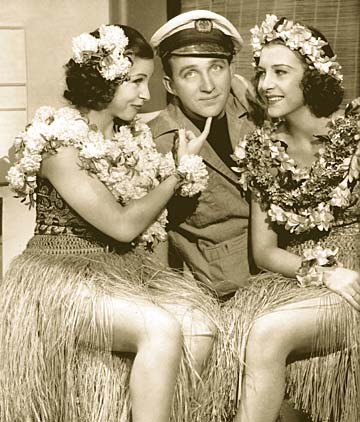


ALTHOUGH it's difficult to estimate the effect of Hollywood's popular films and movies on Hawaii -- except on Robert Cazimero's wardrobe -- we know the inverse is certainly true. A Hawaiian song won an Oscar, but what Hollywood movie ever won a Hoku? Hooray for Hulawood
Hawaii's a longtime movie star
By Burl Burlingame
Star-BulletinWe'll let you know at the end.
But first we asked a couple of Hawaiian film buffs for insight on the films and songs featured in the "Hulawood" fund-raiser. DeSoto Brown, film archivist at Bishop Museum and author of several scholarly paperbacks on Hawaiiana, and Lowell Angell of the University of Hawaii and a leader in local theater preservation, would both rather see a cellophane skirt in black and white than a grass skirt in living color.

Take, "Waikiki Wedding," the Bing Crosby and Martha Raye vehicle. Brown said the movie helped trigger the Hawaiian music fad of the late '30s, a time when America was struggling to lift itself out of a depression. The movie was a huge hit. And Angell notes "Waikiki Wedding" is "a fun story and a delight to watch. Oh sure, it's campy and corny, but you can watch it again and again. It's my second favorite movie set in Hawaii."The first, in case you're wondering, is "Honolulu," made about the same time and starring George Burns and Gracie Allen.
Timing is everything. "Song of the Islands," the big-budget Betty Grable extravaganza released in 1942, was "not quite so light and frothy," said Angell. But that wasn't what did it in at the box office.
"It should have done all right," said Brown. "After all, it was a big, colorful Betty Grable movie with great production values. And it had real Hawaiian musicians in it. But in 1942, just after the Pearl Harbor attack, Hawaii was NOT a romantic destination. And the music was forgettable."
"South Pacific" was already well-established as a Broadway musical when the movie was released, said Brown. "The music was great. But it had very little to do with Hawaii. It was Broadway with a Pacific background."
"Except for the color, 'South Pacific' has held up well, but it can fool you, because some of the scenes were tinted for dramatic effect," said Angell.
Paramount made both "Waikiki Wedding," which introduced the song "Blue Hawaii," and the Elvis Presley hit "Blue Hawaii," so "they had no trouble getting the rights to the song," said Brown. "The two movies even shared the same plot. But the main thing about 'Blue Hawaii' -- which was Elvis' most-popular film -- was that it locked him into the role of the nice guy instead of a rock 'n' roll rebel."
"One of the cool things about 'Blue Hawaii' is that Elvis goes everywhere, and we see how Honolulu has changed in the last 40 years," said Angell.
How about James Garner's "The Castaway Cowboy"?
Neither so-called Hawaiian film "expert" would admit having seen it.
But both love the song "Sweet Leilani," used in "Waikiki Wedding." And yes, "Sweet Leilani" won the Oscar for Harry Owens for Best Song in 1937.
Click for online
calendars and events.